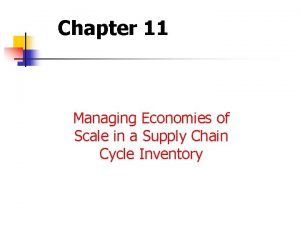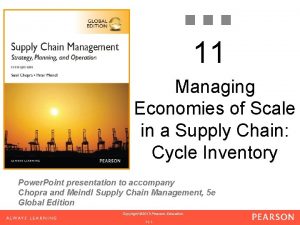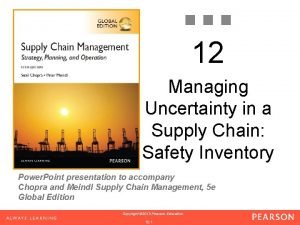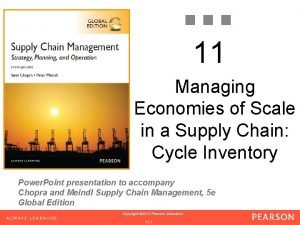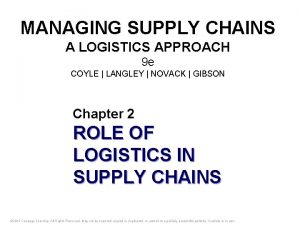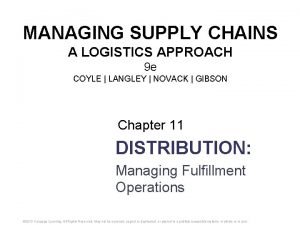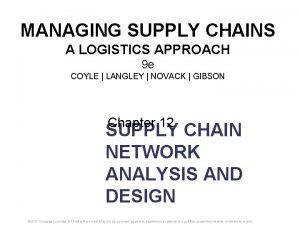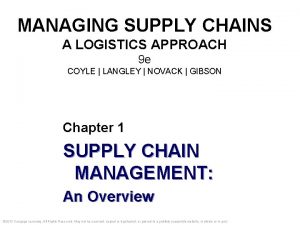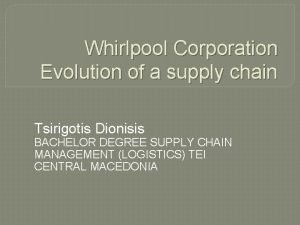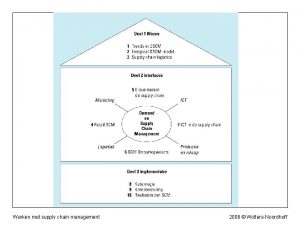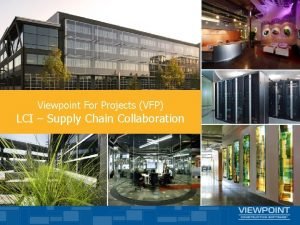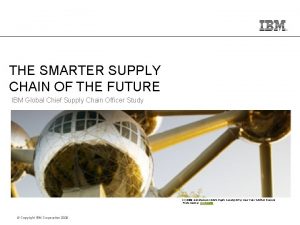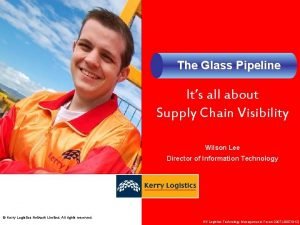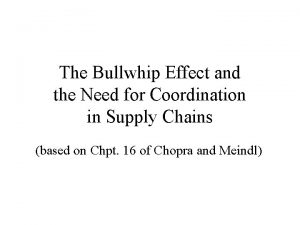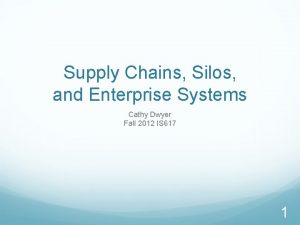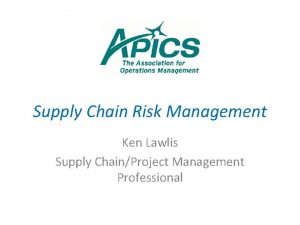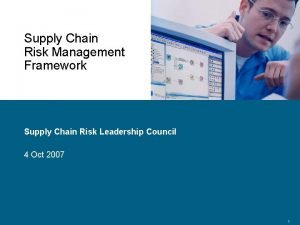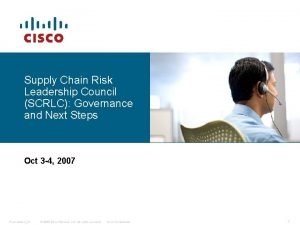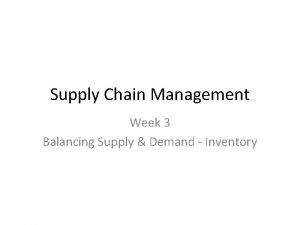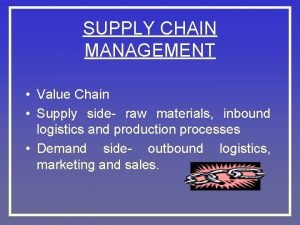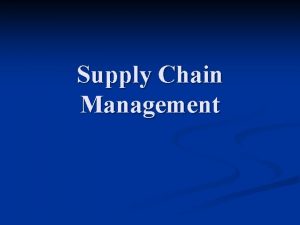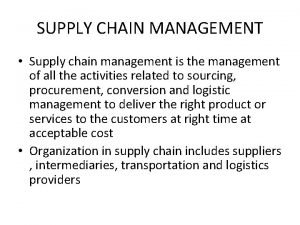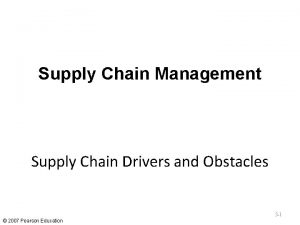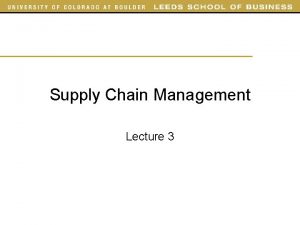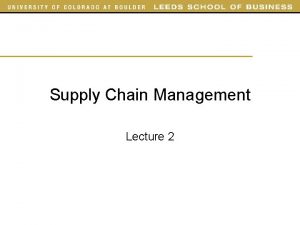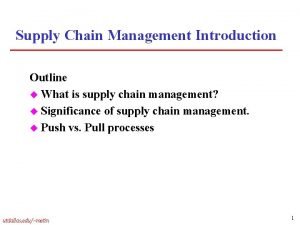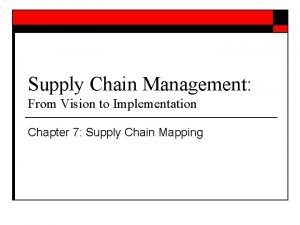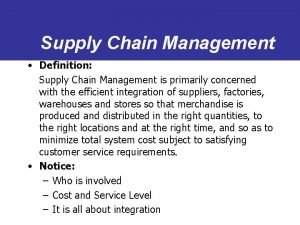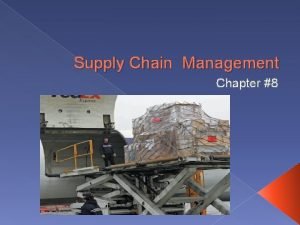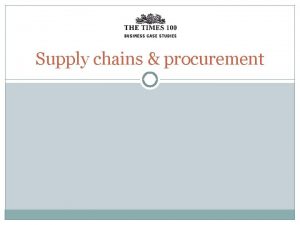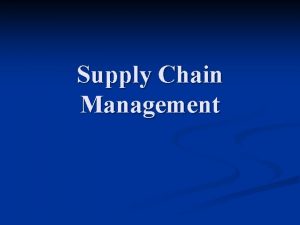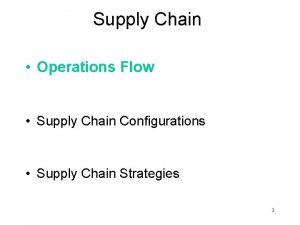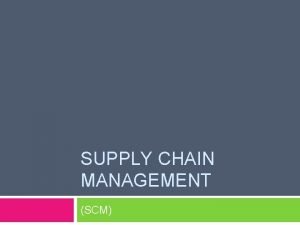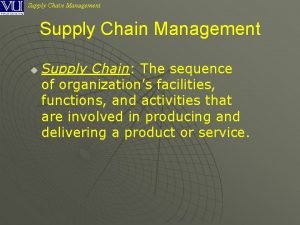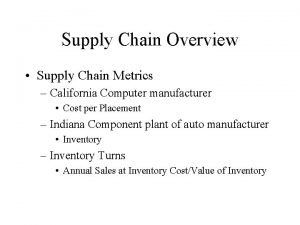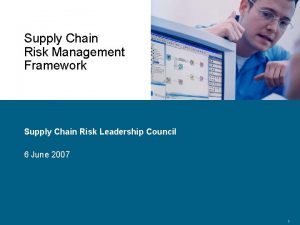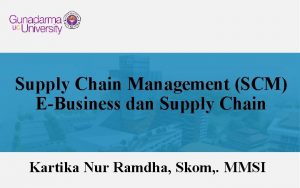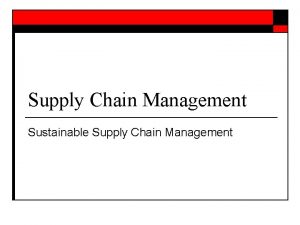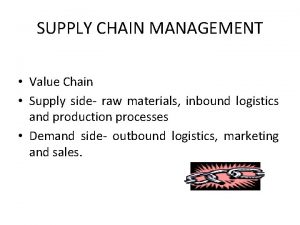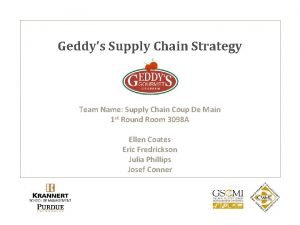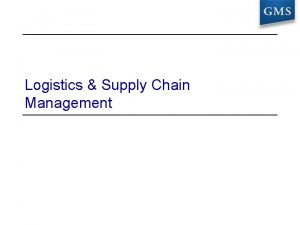Managing the Supply Chain An AI Perspective Mark






































- Slides: 38

Managing the Supply Chain An AI Perspective Mark S. Fox Mihai Barbuceanu, Chris Beck, Andrew Davenport, Mike Gruninger Enterprise Integration Laboratory University of Toronto 4 Taddle Creek Road, Toronto, Ontario M 5 S 3 G 8 tel: 1 -416 -978 -6823 fax: 1 -416 -971 -2479 internet: msf@ie. utoronto. ca http: //www. ie. utoronto. ca/EIL/

The Internet Effect • The Internet has precipitated a major change in how we view retailing and the supply chain – Purchasing is becoming tightly integrated with fulfillment – Customers expect instantaneous response • Produce the product • Tell me when it will be produced • Tell me why it cannot be produced 2

Supply Chain Requirements • The complexity of an enterprise, coupled with uncertainty in the performance of activities, plus the natural distribution of the organization, requires an information architecture where functions are distributed across a networked environment. And are: • Available Flexible – Aware - Informed - - Responsive - Smart 3

Problem • Earlier ERP systems made the transition from static, batch oriented systems, to be more dynamic by incorporating messaging • Never the less, these systems are still largely static – Most modules run on a batch basis or static sequence – Dynamic responses usually left to the human decision maker • We need to re-think how we manage the dynamics of the supply chain – Information technology is making it possible to manage the supply chain in ways not possible ten years ago. 4

Supply Chain Architecture • A network of intelligent software modules that together dynamically manage the supply chain. Each module – is an expert at its task, thereby optimizing its goals – coordinates its decisions with other modules, thereby optimizing supply chain wide goals – quickly responds to changes in cooperation with other modules 5

Information Technology Enablers • Four technologies are having a significant impact on the achievement of this vision: – – The Internet/Web Intelligent Agents Constraint Directed Reasoning Enterprise Models/Ontologies 6

Intelligent Agents • More and more of the tactical and operational decisions will have to be made by software systems that operate more autonomously than they do today. • But, these systems will have to be endowed with operating characteristics a generation beyond what is available today. – We have to strike FIIR into our systems: Fast, Informed, Intelligent Response. • We call this software "intelligent agents” 7

Supply Chain Management Agents Enterprise Wide Per Facility 8

Agent Characteristics • Dynamic: Each agent performs its functions asynchronously in response to events as they occur, modifying its behavior as required. • Goal Directed: can dynamically construct plans in response to events and adapt its plans to new situations. • Intelligent: Each agent is an “expert” in its function. • Least Commitment: The precision with which decisions are made should be inversely proportional to the degree of uncertainty. • Cooperative: Can cooperate with other agents in finding a solution. • Interactive: May work with people to solve a problem - Intelligent Assistants. It can respond to queries and explains its decisions. • Entrusted: Aware of their rights and obligations and therefore trusted. 9

Collaboration • Cultural Assumption: To enable agents to collaborate, we must make assumptions about how their decisions can be influenced, we call this the "cultural assumption” Customer • Agents influence each others behavior by communicating: Goals: Order Acquisition to Assembly Plant: Market Functional Agent "Commit 100 yellow widgets on July 14 to mfg order 49825. " Constraints: on how goals are to be achieved Management Operations "Maximum price for the 100 widgets is $3/widget. " 10

Agent Architecture Coordination Communication Information Distribution Conversation Obligation Management Knowledge Management Constraint-Based Reasoning 11

Coordination Services • An organization is a set of agents playing roles constrained by mutual obligations, permissions, interdictions (OPI). • Obligations triggered by communications in specified situations, create goals in the obliged party. – Incurs costs if not satisfied. – Contradictory obligations exist. • An agent's behavior is determined by plans assigned to its role constrained by obligations, permissions, interdictions and the local situation. 12

Coordination Plans • Agents may carry on multiple, multiple conversations with other agents. The framework includes: – – – conversation objects (both generic classes and instances), conversation rules, conversation continuation rules, error recovery rules, and multiple conversation management. • Coordination plans include both communication with other agents, and invocation of local problem solving methods. 13

Supply Chain Example 14

Benefits • A vision of how information systems will be structured in the future. – Architecture clearly identifies the differing roles of function, information and user access – Agents may dynamically respond to change, coordinating their responses with other agents – Information is distributed to function agents automatically – Information agents manage the evolution of information – Users may tap into other agents, to browse, visualize and change information, limited by their authority 15

Agent Problem Solving Reqts Every functional agent must be able to: • reason about constraints and optimize a set of goals • maximize enterprise flexibility by making "least commitment" decisions, i. e. , maintaining alternatives as long as possible • reveal its goals and constraints when necessary • modify/relax its goals and constraints as part of the negotiation process 16

Constraint-Directed Reasoning • In the last 15 years, a new problem solving paradigm has emerged: Constraint-Directed Reasoning • It is able to consider the myriad of constraints that exist in the organization and construct plans/schedules that satisfy constraints and optimize goals. • It is able to revise these solutions in real-time as changes occur in the market and organization. • It is able to consider tradeoffs among goals/constraints an relax constraints when necessary. 17

Key Concept • Identify the constraint that dominates - and deal with it! 18

Constraint Graph • An integrated representation of all of the variables, e. g. , activity start times, resource assignments, etc. , and their constraints. ST ET Task 1 Task 2 No Weekends Perturbation R 1, R 2 Due Date Utility = Precedence Constraint = Resource Constraint Solution: An assignment of values to every variable such that all constraints are satisfied. 19

How it Works Partial Successive Refinement Schedule Complete Schedule • Remove alternatives that do not satisfy the constraints (Constraint Propagation) • Determine what makes the problem difficult (Measure Textures) • Identify the most critical constraint and make a decision (Opportunistic Commitment) • Backtrack if dead end found (Retraction) 20

Step 1: Constraint Propagation • The domain of a variable may be reduced depending on its linkage to another variable via a constraint Activity 1 Before Activity 2 End Time 1 Start Time 2 21

Step 2: Select Decision Point • Measure Problem Textures: constraint graph properties (e. g. , Contention, Reliance) • Identify Critical Constraint (Opportunism) Task 1 Task 2 22

Step 3: Commitment Least commitment decision maintains as many alternatives as long as possible. • Assign/remove resource • Assign/remove start time • Sequence two or more activities • Retract prior commitment Task 1 Constraint Posting Task 2 23

Least Commitment Decisions • Degree of commitment may vary with domain uncertainty • Allows for flexible local response to change Activity 1 Latest Finish Time Earliest Start Time R 1 R 2 R 3 24

Benefits • Able to consider the myriad of constraints that exist in real domains • Able to relax constraints when no feasible solution exists • Able to negotiate constraints with other agents • Iterative improvement • Anytime performance 25

Information Challenge • Successful management of the supply chain, whether human or agent-based, requires an operating model of the enterprise that is: – Understood and shared by all participants – Able to answer the questions necessary to operate the enterprise, and – As complete, correct and up-to-date as needed. 26

Barrier • The piecemeal development of information systems has led to systems, that are interconnected, but cannot communicate because they do not share the same data models. • ERP products have begun to address this problem, but only within a corporation. 27

Barrier • Much of what we want to know is not represented explicitly in a database, but can be derived from it. • SQL helps but does not solve the problem, especially if answers have to be deduced from the data • Cost of writing programs to derive answers to users' questions is very high. 28

Is the Internet A Panacea? • Some believe the Internet solves this problem. – Wrong: Web standards say nothing about content standards • Some believe that XML is the solution – Possibly, but most likely a Pandora’s Box unless standards are quickly enforced! • What should be standardized? 29

Enterprise Model • An Enterprise Model is a representation, both definition and description, of the structure, processes, resource and information of an identifiable business, government, or other organizational system. • The goal of an enterprise model is to achieve modeldriven enterprise design and operation. 30

Enterprise Modeling Goals • To provide an object library that is a shareable, reusable representation of supply chain information and knowledge. • To define the objects in a precise manner so that it is consistently applied across domains and interpreted by users • To support supply chain tasks by enabling the answering of questions that are not explicitly represented in the model • To support model visualization that is both intuitive, simple and consistent 31

Solution: Ontology • An Ontology is a formal description of entities, their properties and relations among entities. • An ontology is a set of key distinctions necessary to support reasoning. • It is generic across domains. 32

Spoilage Axiom Successor axiom for the fluent spoiled: ( a, r, s) holds(spoiled(r), do(a, )) ((¬holds(spoiled(r), ) � a=spoilage(r)) holds(spoiled(r), )) Precondition axiom: quantity(s, r, q) � enables(s, a) (Poss(a, ) ¬holds(spoiled(r), )) 33

Example Ontologies 34

Example • Given – Crates, pallets, and warehouses of resources • We should be able to answer questions like – How many crates of apples do we have in Warehouse 1? How many overall? – How many pallets contain these crates? – How many apples per crate? How many per pallet? How many per resource unit? – Where do we have at least 10 boxes of bolts? 35

Example • Given – SKUs with code age and spoilage limits – Stock levels and min safety levels of SKUs • We should be able to answer questions like – Will shiptment 10 of oranges spoil if they are not shipped before Friday? – Is any milk spoiled by Wednesday? – Is there any time at which the stock level for bolts at the Scarborough factory reaches the minimum safety level? 36

Benefits • A shareable, reusable representation – Minimally, a language for communicating among legacy agents • A deductive database able to deduce anwers to common sense questions – Reduces the need for ad hoc report generators and interfaces • A standard for visualizing enterprise knowledge – A visual standard across enterprises 37

Conclusion • Most supply chain systems are based on technologies developed in the 60 s and 70 s • Technological changes in the 80 s and 90 s enable us to create the next generation of supply chain management systems – – Internet/Web Agency Theory Constraint-directed reasoning Enterprise Modeling/Ontologies 38
 Managing economies of scale in a supply chain
Managing economies of scale in a supply chain Managing economies of scale in a supply chain
Managing economies of scale in a supply chain Role of safety inventory in supply chain
Role of safety inventory in supply chain Managing economies of scale in a supply chain
Managing economies of scale in a supply chain Matching supply and demand in supply chain
Matching supply and demand in supply chain Difference between logistics and supply chain
Difference between logistics and supply chain Eltonian pyramid
Eltonian pyramid Managing supply chains a logistics approach
Managing supply chains a logistics approach Managing supply chains: a logistics approach
Managing supply chains: a logistics approach Managing supply chains a logistics approach
Managing supply chains a logistics approach Managing supply chains a logistics approach
Managing supply chains a logistics approach Two point perspective house
Two point perspective house Silo perspective vs business process perspective
Silo perspective vs business process perspective Chapter 5 section 1 supply and the law of supply
Chapter 5 section 1 supply and the law of supply Elastisidad ng supply
Elastisidad ng supply Whirlpool corporation evolution of a supply chain
Whirlpool corporation evolution of a supply chain Werken met supply chain management
Werken met supply chain management Viewpoint for project collaboration
Viewpoint for project collaboration Contemporary management practices
Contemporary management practices Ibm supply chain risk management
Ibm supply chain risk management Pipeline in supply chain
Pipeline in supply chain Operational obstacles in supply chain
Operational obstacles in supply chain Supply chain silos
Supply chain silos Supply chain risk register
Supply chain risk register Supply chain risk management framework
Supply chain risk management framework Supply chain risk management framework
Supply chain risk management framework Cisco supply chain risk management
Cisco supply chain risk management Supply chain risk leadership council
Supply chain risk leadership council Safety stock formula
Safety stock formula 4 flows of supply chain
4 flows of supply chain Chain sequence
Chain sequence Supply chain it framework
Supply chain it framework Drivers of supply chain management
Drivers of supply chain management Netflix supply chain
Netflix supply chain Collaborative supply chain
Collaborative supply chain Replenishment cycle in supply chain
Replenishment cycle in supply chain Pipeline in supply chain
Pipeline in supply chain Supply chain management explanation
Supply chain management explanation Supply chain upstream and downstream
Supply chain upstream and downstream
